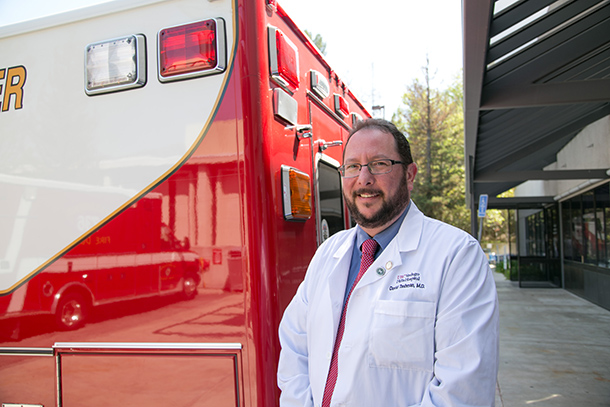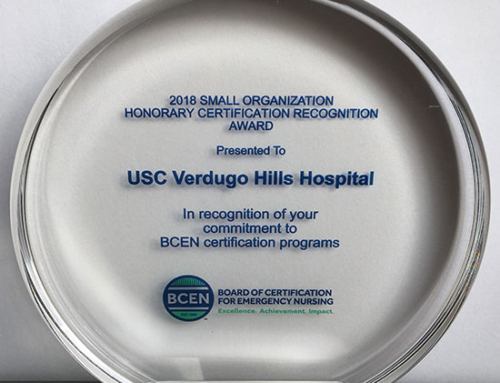Its early symptoms can be confused with those of a cold or flu — which may be why an urgent care doctor thought it was a passing virus that could be treated with rest and over-the-counter medications.
But something inside both Tammy Stradiotto and her husband James Przybyla told them that their son’s complaints of a severe headache that came on suddenly that morning and wouldn’t go away might be a sign something far more serious was wrong.
Sometime just before midnight, Stradiotto and Przybyla, decided he wasn’t getting better and bundled up 7-year-old Tyler for the short trip to USC Verdugo Hills Hospital.
Within minutes, David Tashman, MD, medical director at the USC Verdugo Hills Hospital Department of Emergency Medicine, told the worried parents he believed their son had meningitis. Left untreated, viral, bacterial and other forms of meningitis can lead to permanent disability or even death.
About 1 million people worldwide are affected by meningitis each year — many of them children under age 5, adolescents and young adults, and the elderly. Stradiotto’s mother had lost a brother to meningitis back in 1949, and within days of Tyler’s diagnosis, she said, a local Glendale man whose more severe form of the disease was not immediately treated lost his life.
These patient stories have inspired Tashman, Tyler and his family to educate the public about the importance of diagnosing and treating meningitis within 24 hours after the appearance of symptoms.
“Meningitis can develop rapidly over the course of a few hours, which is why prompt diagnosis and treatment is so critical, and why people need to know what it is, who is at risk of contracting it, and ways to prevent it, particularly in babies, children and anyone with weakened immune systems,” said Tashman, who said he treats a handful of cases of meningitis a year. “Some people misdiagnose meningitis because its symptoms are so similar to the common cold. But with the benefit of years working in the emergency room, I recognized the urgency of the patient’s situation.”
Tashman also had a treatment plan: two powerful antibiotics delivered immediately and continuing for 10 days. Tests, including a lumbar puncture to extract spinal fluid, later confirmed the diagnosis. Because meningitis is infectious, public health officials were notified but found no signs that family members, or students at the boy’s school, had been infected.
Meningitis is an inflammation of the membranes surrounding the brain and spinal cord. Infection, which can be caused by germs, viruses, bacteria, parasites and fungi, is the most common way to contract meningitis. Viral meningitis is the most common and least serious type, while bacterial meningitis is more serious and more frequently ends in permanent disability or death.
It is estimated that about 1 million people worldwide are affected by meningitis each year — many of them children under age 5, adolescents and young adults, and the elderly. Other forms are dangerous but rare.
Early symptoms include headache, fever, stiff neck, irritability, sleepiness, pale complexion, cold extremities, severe joint or leg pain and a lack of appetite. In babies, symptoms include a bulging fontanelle (soft spot on top of the head), a blank stare and limpness. In more serious cases, a rash may be present. The illness is spread by saliva, sneezing, coughing, kissing, touching and sharing utensils.
Most forms of bacterial meningitis can be prevented by vaccines that are widely available, including measles, mumps and rubella (MMR).
Tashman credits Stradiotto with playing a crucial role in the successful diagnosis. “With the meningococcus version of bacterial meningitis, you can be dead in 24 to 48 hours,” Tashman said. “She knew something significant was wrong but wasn’t sure what it was. That’s when you should visit an emergency room.”
By Meg Aldrich





















